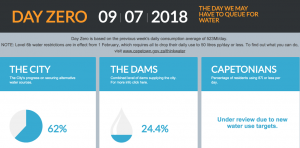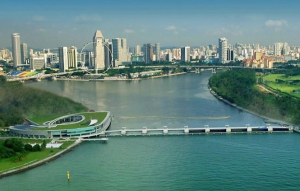by Stephanie Coles
I recently watched a great Ted Talk by Lana Mazahreh, a water conservation activist. I always find Ted Talks insightful, but what was great about this one was the simple and hopeful message behind it: we can work together to solve water crises. How do we do this? Let’s learn from what countries in crisis are already doing.
She opens her talk by walking through the situation in Cape Town, South Africa. In March of 2017, Cape Town was declared a disaster due to the fact that they had less than four months of usable water left. The mayor described needing a new relationship with water. Mindsets needed to shift. Although today water levels are still dangerously low, residents have managed to stretch out the original four-month forecast through water conservation, and the city is still not dry. Mazahreh cites examples from several other cities around the world that have had or are currently experiencing water shortages. She broke down her advice into the following key takeaways.
Lesson 1: Honesty is the best policy
It is crucial to acknowledge the problem. Let citizens know how much water is left, Mazahreh says. From 1997-2009, Australia was facing a severe drought. Water levels in Melbourne dropped to a capacity of 26%. To help combat this, the city used electronic billboards to display exactly how much water was available. Being honest about the issue “creates a sense of urgency and community” and empowers people to take responsibility for fixing the problem. Cape Town has taken that advice to heart. They are using the same electronic billboards that proved effective in Melbourne and a website was created to outline exactly how much water is left in an easy to digest format.

Lesson 2: Empower people to save water
Currently, citizens in Cape Town are only allowed 50 liters of water per person per day.
The tight restrictions are preventing the city from hitting the dreaded “day zero,” the day Cape Town will completely run out of usable water. Again we can look to Melbourne for guidance. Because the city was straight forward about the dangerous water levels, citizens were empowered to take action, and many people invested in rain collection tanks to help with conservation efforts. The city also provided water efficient shower heads for free to help cut back. In a span of four years, these efforts reduced water demands per capita by 50%. In Cape Town, the city has also worked to support their citizens in their water saving efforts. On the city’s government website, resources and tools are available (see below) to help people think through their day and how to best use their supply.

Lesson 3: Look below the surface
In her final takeaway, Mazahreh tells us about Singapore, the 8th most water scarce country in the world. Singapore depends on imported water for 60% of its water needs. In 2008, to help with their shortage, the city built an urban water reservoir called Marina Barrage.

It has “a catchment area of 10,000 hectares, or one-sixth the size of Singapore” that serves three purposes. It helps to boost the water supply by 10%, it lowers the risk of flooding for the surrounding area, and it has become a major attraction visited by tourists and locals alike. Mahahred reminds us that “not all initiatives need to be stunning” like Marina Barrage, but we can think outside the box to help ourselves and each other.
I highly encourage you to listen to Mahahred’s Ted Talk here: 3 Thoughtful Ways to Conserve Water. What is happening with Cape Town is happening around the world. We all need to consider reevaluating our relationship with water. By implementing easy conservation efforts – taking shorter showers, changing to a lower flow faucet, turning off the tap while brushing your teeth – we can work together to make a big difference.
Niger may be able to learn from the successes of other nations as well, but they lack the resources of a country like South Africa to implement them. This is what makes the work Wells Bring Hope is doing so critical. It is also why we teach drip irrigation and the use of grey water in all villages where we drill. Thanks to their familiarity with water scarcity, the villagers in rural Niger have an inherent understanding of the importance of conservation of their most precious resource. Unfortunately, solving the water crisis in Niger is going to take more than the lessons of a Ted Talk, it’s also going to take resources. By partnering with Wells Bring Hope, you’re a part of solving the water crisis for a people in need.


